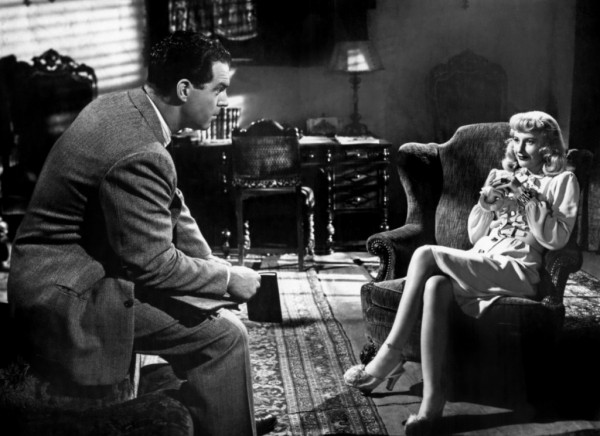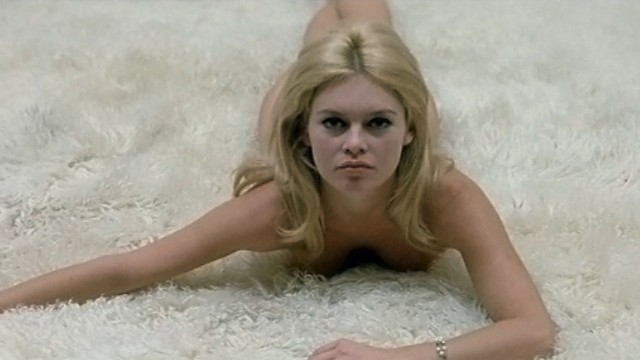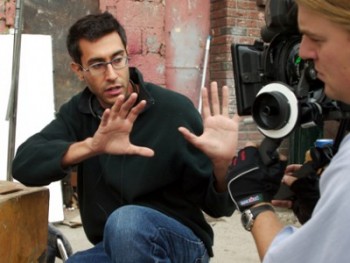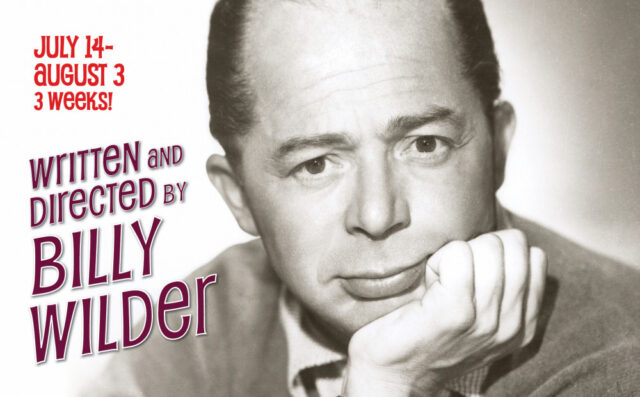
WRITTEN AND DIRECTED BY BILLY WILDER
Film Forum
209 West Houston St.
July 14 – August 3
filmforum.org
“I have ten commandments,” Billy Wilder once said. “The first nine are, thou shalt not bore. The tenth is, thou shalt have right of final cut.” During his more-than-half-century career, the Austria Hungary—born writer and director wrote and/or directed more than fifty films, making unforgettable works in multiple genres, some of which he essentially created himself. Wilder’s films feature well-drawn characters in familiar and not-so-familiar circumstances in plots that take unexpected twists and turns while subtly exploring society at large — and finding humor in almost any situation.
Wilder made comedies and romances, WWII dramas and biopics, courtroom classics and suspense thrillers. Film Forum is celebrating Wilder’s unique skills in the series “Written and directed by Billy Wilder,” consisting of twenty-nine of his pictures, including four that he wrote but did not direct, in addition to the 1935 French farce Fanfare d’amour, the inspiration for Some Like It Hot.
Wilder knew how to get the most of his actors, as you will see in these films, which show off the talents of Barbara Stanwyck, Fred MacMurray, Edward G. Robinson, Ray Milland, Danielle Darrieux, Claudette Colbert, Don Ameche, John Barrymore, Gary Cooper, Greta Garbo, William Holden, Gloria Swanson, Ginger Rogers, Charles Boyer, Olivia de Havilland, Kirk Douglas, Jean Arthur, James Cagney, Marlene Dietrich, Audrey Hepburn, Humphrey Bogart, Marilyn Monroe, Tony Curtis, Jack Lemmon, Walter Matthau, and so many others. Below is a closer look at a handful of the offerings; you really can’t go wrong with any of them, but also high on the must-see list are Stalag 17, Irma la Douce, The Seven Year Itch, The Apartment, Witness for the Prosecution, and One, Two, Three.
“A director must be a policeman, a midwife, a psychoanalyst, a sycophant, and a bastard,” Wilder said. He also pointed out, “If you’re going to tell people the truth, be funny or they’ll kill you.” Wilder died in Beverly Hills in 2002 at the age of ninety-five, having accumulated six Oscars, one honorary Oscar, a Kennedy Center Honor, an AFI Life Achievement Award, a National Medal of Arts, and others, always leaving them laughing.
DOUBLE INDEMNITY (Billy Wilder, 1944)
July 14-17, 31, August 3
filmforum.org
“Written and Directed by Billy Wilder” kicks off with that endlessly romantic noir classic, Double Indemnity. Three years after a brunette Barbara Stanwyck tried to swindle Henry Fonda in Preston Sturges’s The Lady Eve, a blonde Stanwyck is looking for a way out of her loveless marriage when opportunity knocks in the form of acerbic insurance salesman Walter Neff (Fred MacMurray). Stanwyck plays alluring, tough-talking femme fatale Phyllis Dietrichson, who falls for Neff and soon convinces him that they should do away with her husband (Tom Powers). They’re both in it “straight down the line,” as she repeats throughout the film, but insurance fraud investigator Barton Keyes (Edward G. Robinson) isn’t so sure that Mr. Dietrichson’s death was an accident.
John F. Seitz’s inventive black-and-white cinematography — watch for those Venetian blind shadows — set the standard for the genre. MacMurray, who had to be convinced by Wilder to take the part because he thought he’d be awful in the role, is sensational as Neff, oh-so-cool as he recites his cynical dialogue and lights matches with one hand. He might think he’s tough, but he’s no match for Stanwyck, who rules the roost. Both Stanwyck and MacMurray would go on to successful careers in television in the 1960s, he in My Three Sons, she in The Big Valley. Directed by Wilder from a script he wrote with Raymond Chandler based on a pulp novel by James Cain, with music by Miklós Rózsa — how’s that for a pedigree? — Double Indemnity was nominated for seven Oscars and won none.
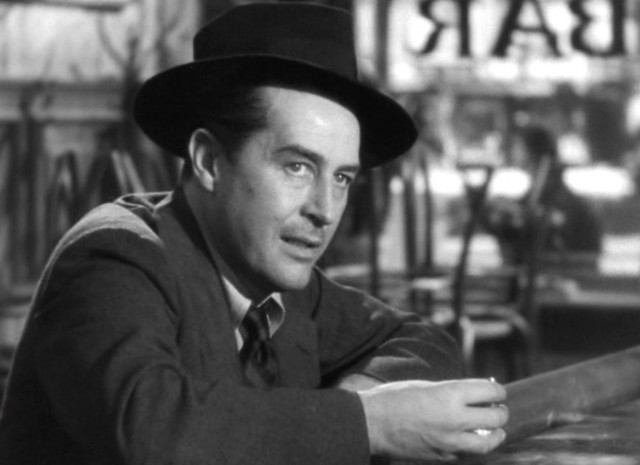
Would-be writer Don Birnam (Ray Milland) battles his demons in Billy Wilder classic The Lost Weekend
THE LOST WEEKEND (Billy Wilder, 1945)
July 14-15, 18, 31, August 1
filmforum.org
Ray Milland won an Oscar as Best Actor for his unforgettable portrayal of Don Birnam in Billy Wilder’s The Lost Weekend, starring as a would-be writer who can see life only through the bottom of a bottle. Having just gotten sober, he is off to spend the weekend with his brother (Phillip Terry), but Don is able to slip away from his girlfriend, Helen (Jane Wyman), and his sibling and hang out mostly with Nat the bartender (Howard Da Silva) and plenty of inner demons. One of the misunderstood claims to fame of Wilder’s classic drama is that it was shot in P. J. Clarke’s on Third Ave.; although the bar in the film was based on Clarke’s, the set was re-created in Hollywood, which doesn’t take anything away from this heartbreaking tale that will not have you running to the nearest watering hole after you see it. The Lost Weekend won three other Academy Awards — Best Screenplay (Wilder and Charles Brackett), Best Director (Wilder), and Best Picture.
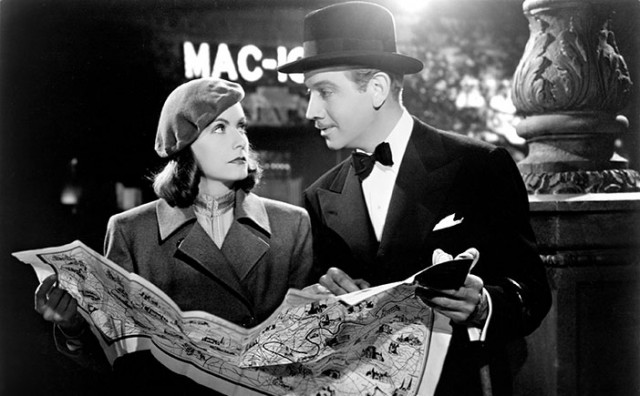
Greta Garbo and Melvyn Douglas get involved in a battle of wits and ideologies in Ernst Lubitsch’s classic romantic comedy Ninotchka
NINOTCHKA (Ernst Lubitsch, 2012)
July 16-17
filmforum.org
Greta Garbo laughs — and says she doesn’t want to be alone — in Ernst Lubitsch’s classic pre-Cold War comedy Ninotchka, written by Billy Wilder, Charles Brackett, and Walter Reisch. In her next-to-last film, Garbo is sensational as Nina Ivanovna “Ninotchka” Yakushova, a Russian envoy sent to Paris to clean up a mess left by three comrade stooges, Iranov (Sig Ruman), Buljanov (Felix Bressart), and Kopalsky (Alexander Granach). The hapless trio from the Russian Trade Board had been sent to France to sell jewelry previously owned by the Grand Duchess Swana (Ina Claire) and now in the possession of the government following the 1917 Russian Revolution. But the duchess’s lover, Count Léon d’Algout (Melvyn Douglas), gets wind of the plan and attempts to break up the deal while also introducing the three men to the many decadent pleasures of a free, capitalist society. Then in waltzes the stern, by-the-book Ninotchka, who wants to set the Russian men straight, as well as Léon. “As basic material, you may not be bad,” she tells him atop the Eiffel Tower, “but you are the unfortunate product of a doomed culture.” At first, Ninotchka speaks robotically, spouting the company line, but she loosens up considerably once Léon shows her what communism has been depriving her of, yet it’s difficult for her to turn her back on the cause, leading to numerous hysterical conversations — the razor-sharp script was written by Charles Brackett, Walter Reisch, and Billy Wilder, based on a story by Melchior Lengyel — that serve as both a battle of the sexes and social commentary on the Russian and French ways of life.
“I’ve heard of the arrogant male in capitalistic society. It is having a superior earning power that makes you that way,” Ninotchka tells Léon shortly after meeting him on a Paris street. “A Russian! I love Russians! Comrade, I’ve been fascinated by your Five-Year Plan for the last fifteen years,” Léon responds, to which Ninotchka tersely replies, “Your type will soon be extinct.” Nominated for four Academy Awards, including Best Picture, Best Actress, Best Original Story, and Best Screenplay, Ninotchka is one of the most delightful romantic comedies ever made, filled with little surprises every step of the way (including a serious cameo by Bela Lugosi), serving up a blueprint that has been followed by so many films for nearly three-quarters of a century ever since.
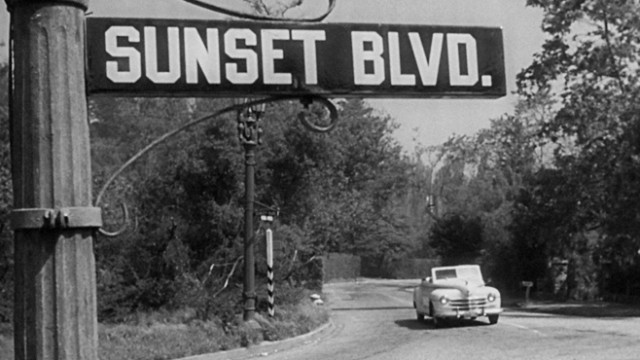
Billy Wilder takes audiences down quite a Hollywood road in Sunset Blvd.
SUNSET BLVD. (Billy Wilder, 1950)
July 17, 22, 23, August 3
filmforum.org
“You’re Norma Desmond. You used to be in silent pictures. You used to be big,” handsome young screenwriter Joe Gillis (William Holden) remarks to an older woman in Billy Wilder’s Sunset Blvd. “I am big. It’s the pictures that got small,” the former star (Gloria Swanson) famously replies. It doesn’t get much bigger than Sunset Boulevard, one of the grandest Hollywood movies ever made about Hollywood. The wickedly entertaining film noir begins in a swimming pool, where Gillis is a floating corpse, seen from below. He then posthumously narrates through flashback precisely what landed him there. On the run from a couple of guys trying to repossess his car, the broke Gillis ends up at a seemingly abandoned mansion, only to find out that it is home to Desmond and her dedicated servant, Max Von Mayerling (Erich von Stroheim). They initially mistake Gillis for the undertaker who is coming to perform a funeral service and burial for Desmond’s pet monkey. (You’ve got to see it to believe it.) When Desmond discovers that Gillis is in fact a screenwriter, she lures him into working with her on her script for a new version of Salome, in which she is determined to play the lead role. “I didn’t know you were planning a comeback,” Gillis says. “I hate that word,” Desmond responds. “It’s a return, a return to the millions of people who have never forgiven me for deserting the screen.” But just as Desmond was unable to make the transition from silent black-and-white films to color and sound pictures, getting Salome off the ground is not going to be as easy as she thinks. Hollywood can be a rather vicious place, after all.
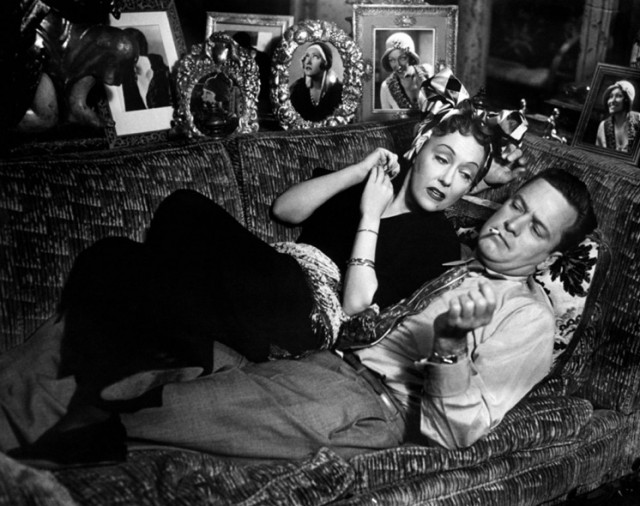
Norma Desmond (Gloria Swanson) keeps a close hold on screenwriter Joe Gillis (William Holden) in Sunset Blvd.
Nominated for eleven Oscars and winner of three — for the sharp writing, the detailed art/set decoration, and Franz Waxman’s score, which goes from jazzy noir to melodrama — Sunset Blvd. wonderfully bites the hand that feeds it, skewering Hollywood while making references to such real stars as Rudolph Valentino, Mabel Normand, John Gilbert, Greta Garbo, Wallace Reid, and Tyrone Power and such films as Gone with the Wind and King Kong. Actual publicity stills and movie posters abound, in Paramount offices and Desmond’s spectacularly designed home, which was once owned by J. Paul Getty and would later be used for Rebel without a Cause. Cecil B. DeMille, who directed Swanson in many silent films, plays himself in the movie, seen on set making Samson and Delilah. Desmond’s fellow bridge players are portrayed by silent stars Buster Keaton, H. B. Warner, and Anna Q. Nilsson. Meanwhile, before Swanson fired him, von Stroheim directed her in the silent film Queen Kelly, which is the movie Max shows Gillis in Desmond’s screening room. (Swanson herself would go on to make only three more feature films; she passed away in 1983 at the age of eighty-four.) John F. Seitz’s black-and-white cinematography and inventive use of camera placement, from underwater to high above the action, makes the most of Hans Dreier’s sets and Swanson’s fabulous costumes and makeup. Sunset Blvd. is the thirteenth and final collaboration between writer-director Wilder and writer-producer Charles Brackett, who together previously made The Lost Weekend and A Foreign Affair. Wilder and Holden would go on to make Stalag 17, Sabrina, and Fedora together. Finally, of course, Sunset Blvd. concludes with one of the greatest quotes in Hollywood history.
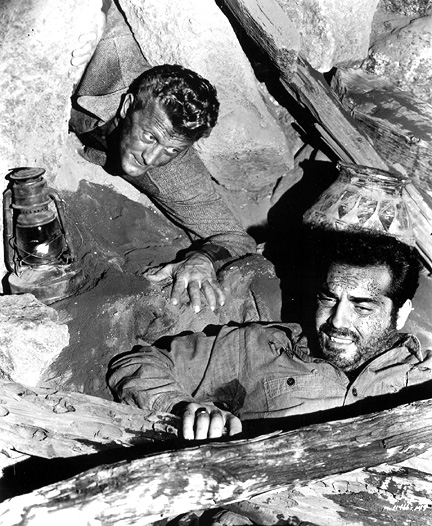
- Kirk Douglas is looking for a way out in Billy Wilder masterpiece Ace in the Hole
ACE IN THE HOLE (Billy Wilder, 1951)
July 20-22
filmforum.org
Sandwiched between such hits as The Lost Weekend, Sunset Blvd., Stalag 17, and Sabrina, Billy Wilder’s Ace in the Hole might just be his least-known masterpiece. A major flop upon its release in 1951, Ace in the Hole is a cynical look at Americans and their values. Chuck Tatum (a classic Kirk Douglas) is a ruthless reporter who has been fired in every major city in the nation because of his love of the bottle, his success with the ladies, and his penchant for playing hard and loose with the facts. He demands a job at a small-town paper in Albuquerque, hoping to land a story that will restore his luster and put him back in the big time. He finds his patsy in the person of Leo Minosa (Richard Benedict), a low-rent Indian artifacts hunter who gets trapped in a cave-in at the base of the Mountain of the Seven Vultures. Sharpening his fangs, Tatum makes a deal with the sheriff (Ray Teal), choosing to take the long way to rescue Minosa in order to keep the sheriff’s name in the news and the reporter’s name on the front page for a longer amount of time. Meanwhile, Minosa’s wife, Lorraine (Jan Sterling, with fabulously uneven eyebrows), who was ready to leave her husband, sees a way for her to cash in as well. The whole thing turns into a huge media circus; in fact, the studio changed the name of the film to The Big Carnival upon its release, trying for a more upbeat title.
CLOSE TO VERMEER
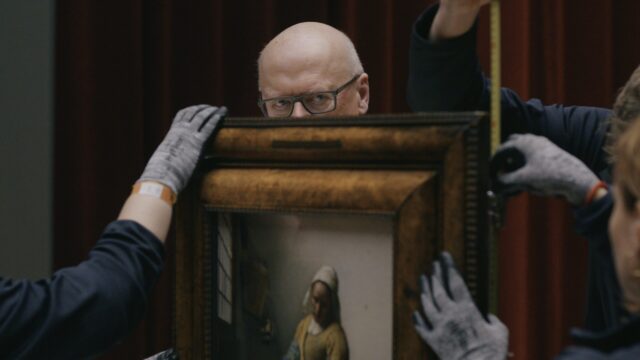
Curator Gregor J. M. Weber studies Vermeer’s The Milkmaid in stunning new documentary
CLOSE TO VERMEER (Suzanne Raes, 2023)
Quad Cinema
34 West 13th St. between Fifth & Sixth Aves.
Through August 3
212-255-2243
quadcinema.com
The first painting I ever fell in love with was Johannes Vermeer’s The Milkmaid. At the time, I knew nothing about it, other than it was this beguiling framed picture in my maternal grandparents’ Brooklyn apartment and, later, one-story home on a canal in a retirement community in Fort Lauderdale. I was still in single digits, so I didn’t understand the concept of a print or a poster; I thought it was the actual painting itself, a fascinating depiction of a woman casually dripping milk from a pitcher into a two-handled bowl on a table with a basket of bread, behind her a bare, somewhat dirty wall.
When I saw the real deal at the Met in 2009, on loan from the Rijksmuseum in Amsterdam, it was joined by all five of the Met’s Vermeers. Seeing The Milkmaid in person left me breathless, sending me back to those days driving down to Florida with my family for our annual February visit; my grandparents and parents are no longer with us, but The Milkmaid is, most recently on view in the internationally hailed Rijksmuseum exhibition simply titled “Vermeer,” consisting of the most Vermeers ever gathered at one venue, twenty-eight of the Dutch artist’s thirty-seven extant works.
Suzanne Raes’s thrilling documentary, Close to Vermeer, goes behind the scenes of the exhibition, following curators, researchers, gallerists, collectors, and conservators as the show comes together, complete with exciting controversies and several big bumps in the road.
“The moment I saw the Vermeers I actually fainted,” exhibition curator Dr. Gregor J. M. Weber says about the first time he experienced Vermeer’s Lady Standing at a Virginal and Lady Seated at a Virginal as a schoolboy on a trip to the National Gallery in London. “The best exhibitions I’ve ever seen didn’t just determine my life during the two hours I was there . . .” He trails off, having to compose himself as he is nearly brought to tears. “A good exhibition should sweep you away. It should change the way you look. Your view of the world changes. As you’re drawn into this other world, and you’re almost floating. Vermeer can really do that.” So can an outstanding documentary.
“What is this mysterious object that I’ve just seen? It looks like it came from Mars and landed down and wanted to say something to me,” painter and Vermeer expert Jonathan Janson remembers upon seeing a photograph of his first Vermeer. He later cannot hold back tears when he sees what he thinks will be the last Vermeer he’ll encounter for the first time: Never again will he have that moment of discovery.

Conservator and researcher Anna Krekeler takes a close look at Vermeer’s The Little Street in Close to Vermeer
The documentary is structured around curators Weber and Pieter Roelofs’s travels to institutions to try to convince them to lend their Vermeers to the exhibit. The Rijksmuseum has four Vermeers; the determined men, individually or as a dynamic duo, head to the Metropolitan Museum of Art in New York City to ask curator Adam Eaker about its five holdings; encounter resistance from curator Silke Gatenbröcker about the Herzog Anton Ulrich Museum in Braunschweig’s one Vermeer, The Girl with a Wineglass; check out the Mauritshuis at The Hague’s three Vermeers, including The Girl with a Pearl Earring, with conservator and researcher Abbie Vandivere, who is so obsessed with the painting that she dyes her dreadlocks Vermeer blue; glory in the three Vermeers at Frick Madison with Frick Collection chief curator Xavier F. Salomon; and battle with curators Betsy Wieseman and Alexandra Libby of the National Gallery in DC over one of its four Vermeers, Girl with a Flute, debating whether it is indeed a legitimate Vermeer or was painted by someone else.
We also hear from research scientist Annelies van Loon, Rijksmuseum general director Taco Dibbits, research conservator Melanie Gifford, and others as they seek to find out more about Vermeer’s process and delve into how the exhibition will be laid out to provide maximum engagement for the expected huge crowds.
The joy these people feel when seeing and studying the paintings is like that of children receiving Christmas presents. “I want to understand how he was able to paint these wonderful pictures,” conservator and researcher Anna Krekeler says, examining The Little Street through a microscope. “Take this red shutter, possibly the most beautiful shutter in the history of art. If you imagine this painting without the red shutter, it’s much less . . . captivating. The red shutter stops you from leaving the painting here, so you keep looking.”
When curator of drawings Maud van Suylen provides evidence that supports Weber’s theory that Vermeer used a camera obscura, which Weber has explored with his partner, Lisanne Wepler, it is like he has uncovered the Holy Grail. One Holy Grail that is not uncovered is any significant new biographical information about Vermeer, who died in December 1675 at the age of forty-three. He had fourteen children but left behind no letters or diaries, and never painted a self-portrait. It is believed that it is his back we see in The Allegory of Painting. “All we have are his paintings,” Weber says.
In her director’s statement, Raes (Two Men, Ganz: How I Lost My Beetle) explains, “Even more than to Rembrandt’s characters or Jan Steen’s debauched scenes, I am drawn to Vermeer’s paintings. The stilled movements and characters he portrayed make you, the viewer, a witness to what was once everyday life. You are close to these people, the room with the large window to the left, the filtered light, the carefully arranged scene. Sometimes the person portrayed is deeply absorbed in reading a letter, pouring milk, looking through a telescope. In the few instances she looks straight at you, she sees straight into your soul.” Raes captures those feelings in her film, which is beautifully photographed by Victor Horstink and edited by Noud Holtman, with lovely music by Alex Simu.
After watching the film, I went to the Met to see A Maid Asleep, Young Woman with a Water Pitcher, Woman with a Lute, Allegory of the Catholic Faith, and Study of a Young Woman, the five works the museum is not allowed to ever lend out. The documentary helped “change the way I look” at paintings, to echo Weber’s words about what a good exhibition should do.
“It’s about the story we want to tell, not the number of paintings,” Weber says as he realizes that the show will go on without every work he hoped would be in the show. He also reveals that this will be the final exhibition he will curate. “This will be my crowning achievement.”
It’s quite an achievement, splendidly illuminated in this engrossing and involving film that, at its heart, is a celebration of the power of great art and how it portrays the human condition.
NAGISA ŌSHIMA: BOY
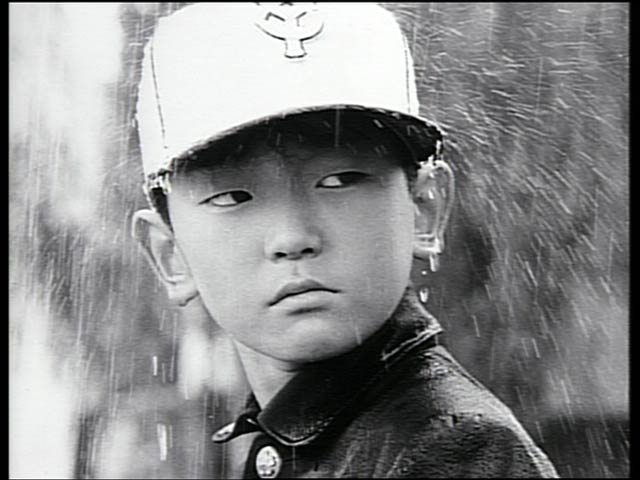
A child (Tetsuo Abe) seeks a better way of life in postwar Japan in Nagisa Oshima’s Boy
BOY (SHONEN) (Nagisa Oshima, 1969)
Anthology Film Archives
32 Second Ave. at Second St.
July 8, 6:00; July 13, 9:15; July 20, 7:00
Festival runs July 7-23
212-505-5181
anthologyfilmarchives.org
Controversial outlaw filmmaker Nagisa Oshima takes a unique, poignant look at the continuing problems in postwar Japan in the underseen 1969 drama Boy. After a major search for an actor to play the nameless title character, Oshima found Tetsuo Abe in an orphanage, and the young boy delivered one of the most memorable performances ever by a child. Inspired by actual events, the film follows wounded war veteran Takeo Omura (Fumio Watanabe), his second, common-law wife, Takeko Taniguchi (Akiko Koyama), their baby (Tsuyoshi Kinoshita), and Omura’s son from his previous marriage, played by Abe and referred to only as “kiddo.” The family travels across Japan, surviving by means of a classic con: First the stepmother, then the boy pretend to be hit by cars so they can extort money from the drivers. Meanwhile, the boy creates an alternate fantasy life that he shares with his baby brother, involving aliens and monsters, the only time he gets to be like a real kid. Otherwise, he is often by himself, never going to school, wandering lonely through the snow or walking down an empty path on one side of the screen as children play boisterously on the other side. As the authorities close in on the family, tragedy awaits.
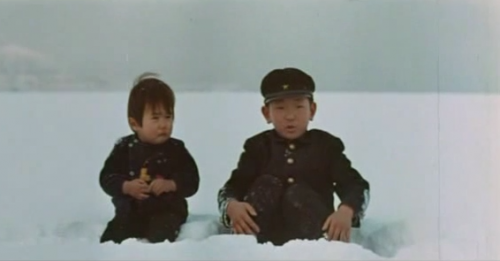
Nameless brothers (Tsuyoshi Kinoshita and Tetsuo Abe) experience troublesome circumstances in Boy
Best known for radical, cutting-edge films filled with violence and sexuality, including Cruel Story of Youth, In the Realm of the Senses, and Taboo — as well as Max, Mon Amour, in which Charlotte Rampling plays a diplomat’s wife who falls in love with a chimpanzee — Oshima shows a warm, gentle touch in Boy, led by a tender lead performance by Abe, who is often shown standing firmly, dressed in a uniformlike outfit, like a little soldier. Oshima and cinematographers Yasuhiro Yoshioka and Seizo Sengen bathe the film in bursts of yellow, blue, and red, setting the bright colors against an essentially black-and-white palette that turns a haunting blue and then sepia near the end, accompanied by Hikaru Hayashi’s evocative, wide-ranging score. Hovering around the tale, which serves as a parable for the many troubles families experienced after World War II and is perhaps most reminiscent of François Truffaut’s nouvelle vague standard-bearer, The 400 Blows, is the Japanese flag; the father and the baby wave a small one in their hands, the family stops underneath one when figuring out their next move, and a large one taunts them on a back wall as the father berates the stepmother in a hotel room.
Through it all, the boy remains steadfast. “I’m a cosmic messenger of justice,” he declares to his baby brother. Boy turned out to be Abe’s only film, as he returned to the orphanage after it was finished. Boy is screening July 8, 13, and 20 in an eight-film Anthology Film Archives series that runs July 7-23 and also includes Pleasures of the Flesh, Japanese Summer: Double Suicide, Diary of a Shinjuku Thief, The Man Who Left His Will on Film, The Ceremony, Death by Hanging, and Merry Christmas, Mr. Lawrence, all shown in 35mm.
MIDNIGHT COWBOY / DESPERATE SOULS, DARK CITY AND THE LEGEND OF MIDNIGHT COWBOY
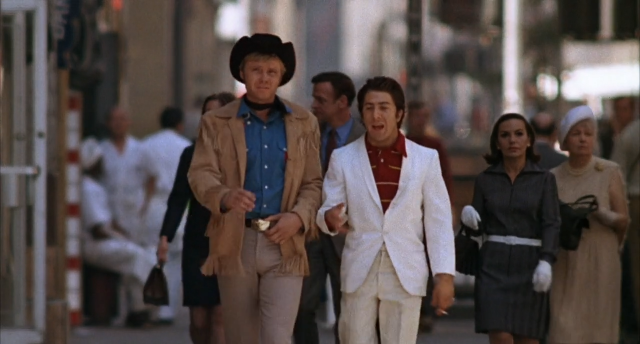
Oscar nominees Jon Voight and Dustin Hoffman try to make it in the big city in John Schlesinger’s powerful Midnight Cowboy
MIDNIGHT COWBOY (John Schlesinger, 1969)
DESPERATE SOULS, DARK CITY AND THE LEGEND OF MIDNIGHT COWBOY (Nancy Biurski, 2022)
Film Forum
209 West Houston St.
Opens Friday, July 7
212-727-8110
filmforum.org
The only X-rated film to win a Best Picture Oscar, John Schlesinger’s masterful Midnight Cowboy follows the exploits of Joe Buck (Jon Voight), a friendly sort of chap who leaves his small Texas town, determined to make it as a male prostitute in Manhattan. Wearing his cowboy gear and clutching his beloved transistor radio, he trolls the streets with little success. Things take a turn when he meets up with Enrico Salvatore “Ratso” Rizzo (Dustin Hoffman), an ill, hobbled con man living in a condemned building. The two loners soon develop an unusual relationship as Buck is haunted by nightmares, shown in black-and-white, about his childhood and a tragic event that happened to him and his girlfriend, Crazy Annie (Jennifer Salt), while Rizzo dreams of a beautiful life, depicted in bright color, without sickness or limps on the beach in Miami.
Adapted by Waldo Salt (Serpico, The Day of the Locust) from the novel by James Leo Herlihy, Midnight Cowboy is essentially a string of fascinating and revealing set pieces in which Buck encounters unusual characters as he tries desperately to succeed in the big city; along the way he beds an older, wealthy Park Ave. matron (Sylvia Miles), is asked to get down on his knees by a Bible thumper (John McGiver), gets propositioned in a movie theater by a nerdy college student (Bob Balaban), has a disagreement with a confused older man (Barnard Hughes), and attends a Warholian party (thrown by Viva and Gastone Rosilli and featuring Ultra Violet, Paul Jabara, International Velvet, Taylor Mead, and Paul Morrissey) where he hooks up with an adventurous socialite (Brenda Vaccaro).
Photographed by first-time cinematographer Adam Holender (The Panic in Needle Park, Blue in the Face), the film captures the seedy, lurid environment that was Times Square in the late 1960s; when Buck looks out his hotel window, he sees the flashing neon, with a sign for Mutual of New York front and center, the letters “MONY” bouncing across his face with promise. The film is anchored by Harry Nilsson’s Grammy-winning version of “Everybody’s Talkin’,” along with John Barry’s memorable theme. Iconic shots are littered throughout, along with such classic lines as “I’m walkin’ here!”
Midnight Cowboy, which was nominated for seven Oscars and won three (Best Picture, Best Adapted Screenplay, and Best Director), is screening at Film Forum in conjunction with the theatrical release of Nancy Buirski’s Desperate Souls, Dark City and the Legend of Midnight Cowboy, which is not a typical making-of documentary; inspired by Glenn Frankel’s 2021 book, Shooting Midnight Cowboy: Art, Sex, Loneliness, Liberation, and the Making of a Dark Classic, Buirski explores the social context in which Midnight Cowboy was created and brought to the public. The film opens with Voight telling a great story about the day shooting wrapped:
“That’s the last shot. . . . John [Schlesinger], he was like this, shaking. I said, ‘John, what’s the matter?’ He said, ‘What have we done? What have we done? We’ve made a movie about a dishwasher who goes and fucks a lot of women in New York. What’ll they say? What’ll they say about this picture?’ I said, and I knew he’s having a complete meltdown, right? I didn’t know what to do. I mean, I was his friend, I want to help him. I grabbed him by the shoulders and I said, ‘John,’ — I looked him in the eye — ‘we will live the rest of our artistic lives in the shadow of this great masterpiece.’ He looks up, ‘You think so?’ [Voight laughs] I said, ‘I’m absolutely certain of it.’ It was the only thing that could get him out of it. I said the most ridiculous thing I could think of but . . . turned out to be true.”
Buirski (The Loving Story, Afternoon of a Faun: Tanaquil Le Clercq) speaks with Jennifer Salt, the daughter of Waldo Salt, who played Crazy Annie; Bob Balaban, who portrayed the college student in the movie theater; Brenda Vaccaro, who plays the socialite; cultural critic Lucy Sante; Schlesinger’s nephew, author Ian Buruma; film critic James Hoberman; Charles Kaiser, author of The Gay Metropolis; photographer Michael Childers, Schlesinger’s longtime partner; and cinematographer Adam Holender, who contributes modern-day photos of New York City. Writer, director, and producer Buirski and editor Anthony Ripoli include a barrage of archival color and black-and-white footage of the Vietnam War, Times Square, the Chicago Seven, and the moon landing; clips from dozens and dozens of movies, from The Graduate, Easy Rider, The Sound of Music, Flaming Creatures, The Boys in the Band, Taxi Driver, and numerous Westerns and Andy Warhol works to such other Schlesinger films as A Kind of Loving, Billy Liar, Darling, and Sunday Bloody Sunday. There are also snippets of older interviews with Waldo Salt, James Leo Herlihy, and Dustin Hoffman; Voight’s original screen test with Salt; and home movies of Schlesinger, who died in 2003 at the age of seventy-seven.
Desperate Souls focuses on the changing postwar class system; homoeroticism, particularly as it relates to the macho image of cowboys, from John Wayne to the Marlboro Man; and the transformation of pop culture in the 1970s, with a soundtrack that includes songs by Don McLean, the Guess Who, Gerry & the Pacemakers, and Janis Ian. There’s a significant amount of information overload about the era and Midnight Cowboy’s legacy instead of more behind-the-scenes details, but you can find out more when Buirski and Holender take part in a Q&A following the 6:00 screening on July 7 at Film Forum.
60th ANNIVERSARY 4K RESTORATION: CONTEMPT
CONTEMPT (LE MEPRIS) (Jean-Luc Godard, 1963)
Film Forum
209 West Houston St.
June 30 – July 13
212-727-8110
www.filmforum.org
French auteur Jean-Luc Godard, who died last September at the age of ninety-one, didn’t hold back any of his contempt for Hollywood cinema in his multilayered masterpiece Contempt, which is being shown June 30 – July 13 in a sixtieth-anniversary 4K restoration at Film Forum. Loosely based on Alberto Moravia’s Il Disprezzo, Contempt stars Michel Piccoli as Paul Javal, a French screenwriter called to Rome’s famed Cinecittà studios by American producer Jeremy Prokosch (Jack Palance ) to perform rewrites on Austrian director Fritz Lang’s (played by Lang himself) adaptation of The Odyssey by ancient Greek writer Homer. Paul brings along his young wife, the beautiful Camille (Brigitte Bardot), whom Prokosch takes an immediate liking to. With so many languages being spoken, Prokosch’s assistant, Francesca Vanini (Giorgia Moll), serves as translator, but getting the various characters to communicate with one another and say precisely what is on their mind grows more and more difficult as the story continues and Camille and Paul’s love starts to crumble. Contempt is a spectacularly made film, bathed in deep red, white, and blue, as Godard and cinematographer Raoul Coutard poke fun at the American way of life. (Both Godard and Coutard appear in the film, the former as Lang’s assistant director, the latter as Lang’s cameraman — as well as the cameraman who aims the lens right at the viewer at the start of the film.)
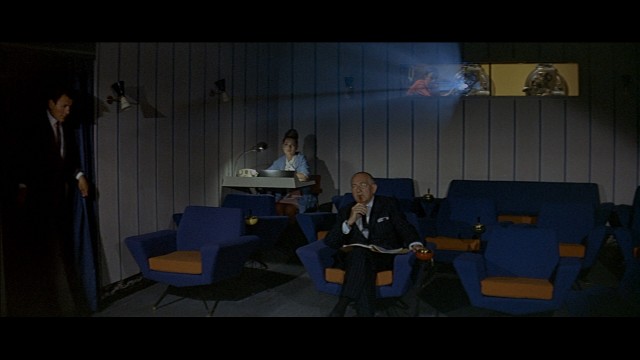
Producer Jeremy Prokosch (Jack Palance) doesn’t always have the kindest of words for director Fritz Lang in Contempt
Bardot is sensational in one of her best roles, whether teasing Paul at a marvelously filmed sequence in their Rome apartment (watch for him opening and stepping through a door without any glass), lying naked on the bed, asking Paul what he thinks of various parts of her body (while Coutard changes the filter from a lurid red to a lush blue), or pouting when it appears that Paul is willing to pimp her out in order to get the writing job. Palance is a hoot as the big-time producer, regularly reading fortune-cookie-like quotes from an extremely little red book he carries around that couldn’t possibly hold so many words. And Lang, who left Germany in the mid-1930s for a career in Hollywood, has a ball playing a version of himself, an experienced veteran willing to put up with Prokosch’s crazy demands. Vastly entertaining from start to finish, Contempt is filled with a slew of inside jokes about the filmmaking industry and even Godard’s personal and professional life, along with some of the French director’s expected assortment of political statements and a string of small flourishes that are easy to miss but add to the immense fun, all set to a gorgeous romantic score by Georges Delerue.
QUEENS ON SCREEN: CHOP SHOP
CHOP SHOP (Ramin Bahrani, 2007)
Museum of the Moving Image
35th Ave. at 36th St., Astoria
Friday, June 30, at 7:30
Sunday, July 2, 2:00
718-777-6800
movingimage.us
Set amid the junkyards and auto-body shops in the shadow of Shea Stadium, Ramin Bahrani’s follow-up to his indie hit Man Push Cart is a gritty, realistic drama of family and community. Filmed in thirty days in the Iron Triangle neighborhood of Willets Point, Queens, Chop Shop stars Alejandro Polanco as Ale, a street-smart twelve-year-old boy who works for Rob (Rob Sowulski), calling cars into the repair shop, stealing spare parts, and learning virtually every aspect of the trade, legal and not. Ale lives in a small upstairs room in the garage with his sister, sixteen-year-old Isamar (Isamar Gonzalez), who by day works in a food van and at night makes extra cash by getting into cars and trucks with strange men. Neither Ale nor Izzy goes to school; instead, they’re working hard, saving up money to buy a food van and start their own business, but their life is fraught with danger and difficulty nearly every step of the way. Written by Bahrani (Goodbye Solo, At Any PriceChop Shop is an honest, frightening, yet sweet slice of life that takes place not far from a sign at Shea that announces, “Where Dreams Happen.”
Polanco gives a remarkable performance as Ale, a rough yet vulnerable kid who has been dealt a tough hand but just forges ahead, attempting to make the most out of his meager life, trying to find his own piece of the American dream. Whether hanging out with his best friend, Carlos (Carlos Zapata), looking after his sister, doing a special job for Ahmad (Man Push Cart’s Ahmad Razvi), or counting his pay in front of his boss – Sowulski really does own the garage where most of the movie is filmed – Ale is an extraordinary character, played by an extraordinary young boy in his very first film. A subtle, unforgettable experience, Chop Shop is screening June 30 and July 2 in the ongoing Museum of the Moving Image series “Queens on Screen,” which previously presented such films as The Wiz, The Untouchables, and Kiss of Death.
THE ALARM: NEW YORK GATHERING 2023
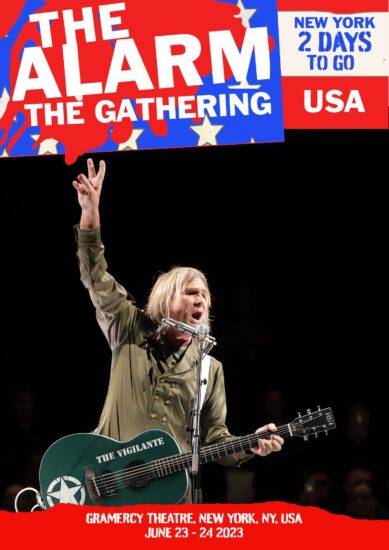
THE ALARM
Gramercy Theatre
127 East 23rd St. at Lexington Ave.
Friday, June 23, and Saturday, June 24, $53-$120
Free special events June 22 and June 25
www.livenation.com
thealarm.com
During the pandemic and continuing to today, one of my favorite social media messages has been “The Alarm Is Live,” referring to the Welsh rock band that goes back to the early 1980s. Most recently, the pop-up came with a second meaning, as, for decades, group cofounder and lead vocalist Mike Peters has been battling cancer, including lymph cancer in 1996 and chronic lymphocytic leukemia in 2005, which came back this past September.
As he explained on the band’s website, “I am writing today to let you all know that my leukemia (CLL) has relapsed and I have been admitted to the North Wales Cancer Centre for immediate treatment. I have already started on a brand new chemotherapy regime and so I wanted you to know, personally, that my life living with cancer is about to change for the foreseeable future. My immediate aim is to get fit and well for the Gathering. . . . This coming January will commemorate the thirtieth anniversary of the Gathering, an event that has come to represent all that we stand for — thirty years of Love Hope and Strength, thirty years of friendship and celebration and, through music, helping each other to live life and stay strong. I want you to know that I am going to beat this disease once more and be ready, willing, and able to hit the stage. . . . Since being diagnosed with pneumonia (after the last British tour), the post-recovery period provided far greater challenges for me than I could ever have envisaged (although somehow I managed to find the strength to record the backing tracks for a new Alarm album. I’ve even got my guitar with me on the ward just in case inspiration strikes!)”
Inspiration did strike, as Peters, joined by his wife, keyboardist Jules Jones Peters, kept going live on Facebook, sharing music and stories, even from his hospital bed, while continuing their series “The Big Night In.” Late last month, Peters took off on a solo acoustic tour of England, playing thirty-song sets of Alarm tunes, from the anthemic ’80s hits “Sixty Eight Guns” (“And now they are trying to take my life away / Forever young I cannot stay”), “Blaze of Glory” (“Going out in a blaze of glory / My heart is open wide / You can take anything that you want from me / There is nothing left to hide”), and “The Stand” (“Come on down and meet your maker / Come on down and make the stand / Come on down, come on down / Come on down and make the stand”) to tracks from their brand-new album, Forwards, written from the perspective of an older, wiser man who has looked death in the face — “Forwards” (“In the cities all deserted / In the streets of emptiness / In the church of nonbelievers / I’ve been searching for the way to find new faith . . . I’ve been trying to get myself back home to you / I’m living for today / Trying to find the way forwards”), “Next” (“All the clocks are set to zero, now’s the time to run / I hear the crack of the starting gun and I’m ready for what’s next / All is possible / All is understood / Whatever is trying to kill me makes me feel alive”), and “Transition” (“There’s a line I have to cross tonight / If I want to stay alive and live for a second time / Knowing time / The way it’s passing by / I can’t afford to wait / To see the light of day”).
Peters, who is sixty-four, and the Alarm return to New York City this week for the Gathering, a four-day celebration that begins June 22 at 6:00 with a solo acoustic set and record signing at Rough Trade in Rockefeller Plaza. On Friday and Saturday, Peters and his bandmates — James Stevenson on guitar and bass, Mark Taylor on keyboards and guitar, Steve “Smiley” Barnard on drums, and Jules on keyboards — will be performing at the Gramercy Theatre, with each night offering unique surprises, including acoustic sets, film screenings, and a Q&A for two-day-pass holders. The festivities conclude with a ninety-minute hike around the Central Park lake on Sunday at 11:30 am beginning at Bethesda Fountain in support of Peters’s charity, the Love Hope Strength Foundation, whose mission is “to save lives, one concert at a time”; you can register in advance here.
On the Alarm’s “Diary of a Rock & Roll Life” Facebook posts, Jules wrote on May 9, after Mike got good news from the North Wales Cancer Treatment Centre, “Just being healthy is the greatest gift of all.” Another great gift is Mike Peters and the Alarm back onstage in NYC for these special shows. “The Alarm Is Live,” and this time in person.
